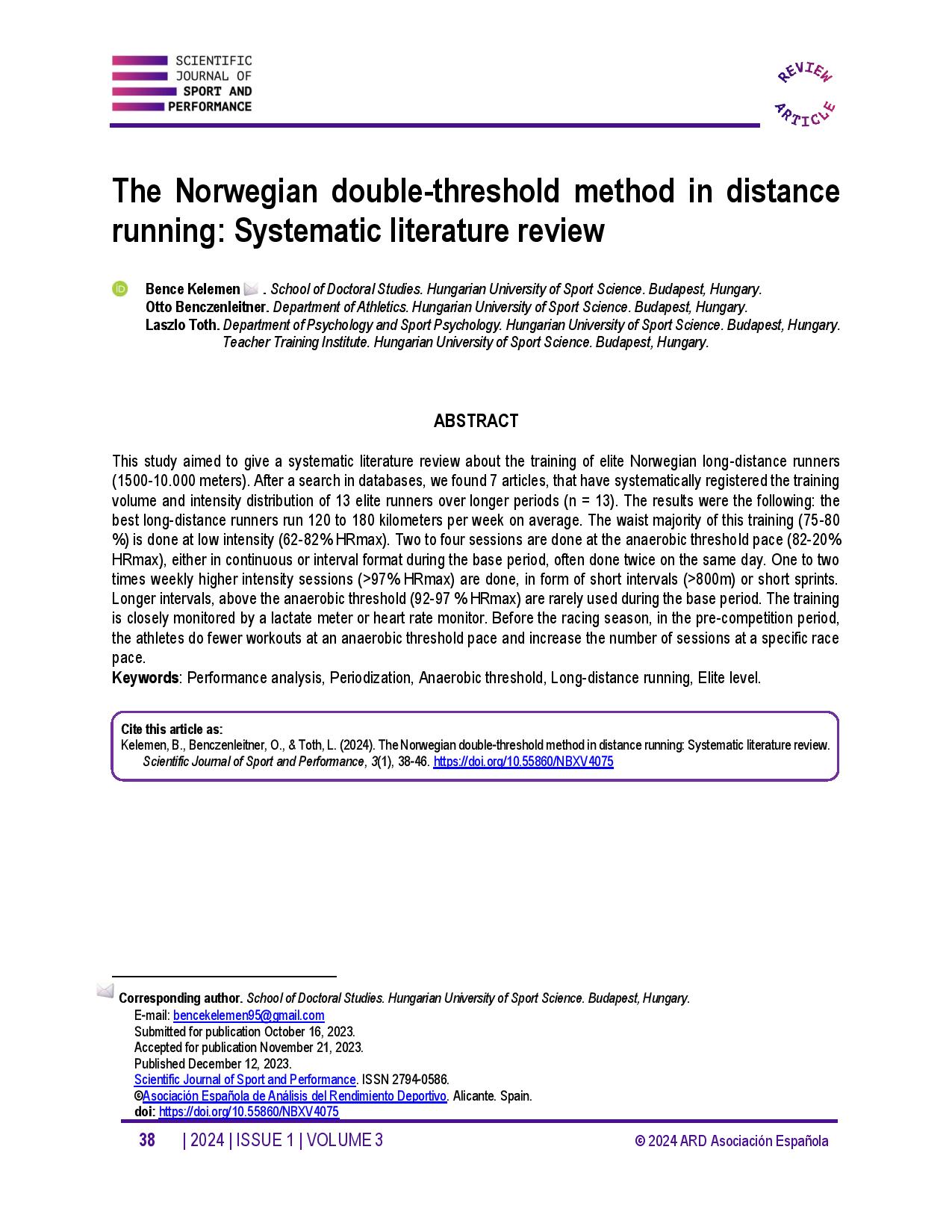The Norwegian double-threshold method in distance running Systematic literature review
Main Article Content
Abstract
This study aimed to give a systematic literature review about the training of elite Norwegian long-distance runners (1500-10.000 meters). After a search in databases, we found 7 articles, that have systematically registered the training volume and intensity distribution of 13 elite runners over longer periods (n = 13). The results were the following: the best long-distance runners run 120 to 180 kilometers per week on average. The waist majority of this training (75-80 %) is done at low intensity (62-82% HRmax). Two to four sessions are done at the anaerobic threshold pace (82-20% HRmax), either in continuous or interval format during the base period, often done twice on the same day. One to two times weekly higher intensity sessions (>97% HRmax) are done, in form of short intervals (>800m) or short sprints. Longer intervals, above the anaerobic threshold (92-97 % HRmax) are rarely used during the base period. The training is closely monitored by a lactate meter or heart rate monitor. Before the racing season, in the pre-competition period, the athletes do fewer workouts at an anaerobic threshold pace and increase the number of sessions at a specific race pace.
Article Details

This work is licensed under a Creative Commons Attribution-NonCommercial-ShareAlike 4.0 International License.
Funding data
References
Bakken M. (2021). The Norwegian model. Retrieved from: http://www.mariusbakken.com/the-norwegian-model.html (2021, acessed 25 January 2022)
Bengtsson J. (2019). Kalle Berlgrund training program. Retrieved from: https://pajulahti.com/wp-content/uploads/2020/01/Jan-Bengtsson-Pajulahti.pdf (2019, accessed 25 January 2022)
Brandon L. J. (1995). Physiological factors associated with middle distance running performance. Sports medicine (Auckland, N.Z.), 19(4), 268-277. https://doi.org/10.2165/00007256-199519040-00004 DOI: https://doi.org/10.2165/00007256-199519040-00004
Casado, A., Foster, C., Bakken, M., & Tjelta, L. I. (2023). Does Lactate-Guided Threshold Interval Training within a High-Volume Low-Intensity Approach Represent the "Next Step" in the Evolution of Distance Running Training? International Journal of Environmental Research and Public Health, 20(5), 3782. https://doi.org/10.3390/ijerph20053782 DOI: https://doi.org/10.3390/ijerph20053782
Casado, A., Hanley, B., Santos-Concejero, J., & Ruiz-Pérez, L. M. (2021). World-Class Long-Distance Running Performances Are Best Predicted by Volume of Easy Runs and Deliberate Practice of Short-Interval and Tempo Runs. Journal of strength and conditioning research, 35(9), 2525-2531. https://doi.org/10.1519/JSC.0000000000003176 DOI: https://doi.org/10.1519/JSC.0000000000003176
Conley, D. L., & Krahenbuhl, G. S. (1980). Running economy and distance running performance of highly trained athletes. Medicine and science in sports and exercise, 12(5), 357-360. https://doi.org/10.1249/00005768-198025000-00010 DOI: https://doi.org/10.1249/00005768-198025000-00010
Filipas, L., Ballati, E. N., Bonato, M., La Torre, A., & Piacentini, M. F. (2018). Elite male and female 800-m runners' display of different pacing strategies during Season-Best performances. International Journal of Sports Physiology and Performance, 13(10), 1344-1348. https://doi.org/10.1123/ijspp.2018-0137 DOI: https://doi.org/10.1123/ijspp.2018-0137
Gastin, P. B. (2001). Energy system interaction and relative contribution during maximal exercise. Sports Medicine, 31(10), 725-741. https://doi.org/10.2165/00007256-200131100-00003 DOI: https://doi.org/10.2165/00007256-200131100-00003
Haugen, T., Sandbakk, Ø., Enoksen, E., Seiler, S., & Tønnessen, E. (2021). Crossing the Golden Training divide: the science and practice of training World-Class 800- and 1500-m runners. Sports Medicine, 51(9), 1835-1854. https://doi.org/10.1007/s40279-021-01481-2 DOI: https://doi.org/10.1007/s40279-021-01481-2
Karikosk O. (1984) Training Volume in Distance Running, Modern Athlete and Coach, 1984, 22(2), 18-20.
Kelemen B., Béres S., Szalma L., Gyimes Zs.(2020). A tactical comparison of men's middle distance running. Magyar Sporttudományi Szemle 2020; 21/ 85, 2020/3, 58-59.
Midgley, A. W., McNaughton, L. R., & Jones, A. M. (2007). Training to enhance the physiological determinants of long-distance running performance: can valid recommendations be given to runners and coaches based on current scientific knowledge?. Sports medicine (Auckland, N.Z.), 37(10), 857-880. https://doi.org/10.2165/00007256-200737100-00003 DOI: https://doi.org/10.2165/00007256-200737100-00003
Noakes, T. (2001). Physiological capacity of the elite runner. Running & Science-in an interdisciplinary perspective. Copenhagen: Institute of Exercise and Sports Sciences, University of Copenhagen, Munksgaard, 19-47.
Noakes, T. D., Myburgh, K. H., & Schall, R. (1990). Peak treadmill running velocity during theVO2max test predicts running performance. Journal of Sports Sciences, 8(1), 35-45. https://doi.org/10.1080/02640419008732129 DOI: https://doi.org/10.1080/02640419008732129
Seiler S. (2010). What is best practice for training intensity and duration distribution in endurance athletes?. International journal of sports physiology and performance, 5(3), 276-291. https://doi.org/10.1123/ijspp.5.3.276 DOI: https://doi.org/10.1123/ijspp.5.3.276
Seiler, K. S., & Kjerland, G. Ø. (2004). Quantifying training intensity distribution in elite endurance athletes: is there evidence for an "optimal" distribution? Scandinavian Journal of Medicine & Science in Sports, 16(1), 49-56. https://doi.org/10.1111/j.1600-0838.2004.00418.x DOI: https://doi.org/10.1111/j.1600-0838.2004.00418.x
Seiler, S., & Tønnessen, E. (2009). Intervals, Thresholds, and Long Slow Distance: the Role of Intensity and Duration in Endurance Training.
Tjelta LI, Rønning TA, Dyrstad S. (2012) Relationship between Velocity at Anaerobic Threshold and Factors Affacting Velocity at Anaerobic Threshold in Elite Distance Runners. International Journal of Applied Sports Sciences. 2012; 24. 8-17. https://doi.org/10.24985/ijass.2012.24.1.8 DOI: https://doi.org/10.24985/ijass.2012.24.1.8
Tjelta, A.R., & Tjelta, L.I. (2011). Distribution of Training Volume and Intensity of Elite Male and Female Track and Marathon Runners. International Journal of Sports Science & Coaching, 6, 273 - 293. https://doi.org/10.1260/1747-9541.6.2.273 DOI: https://doi.org/10.1260/1747-9541.6.2.273
Tjelta, L. I. (2016). The training of international level distance runners. International Journal of Sports Science & Coaching, 11(1), 122-134. https://doi.org/10.1177/1747954115624813 DOI: https://doi.org/10.1177/1747954115624813
Tjelta, L. I. (2019). Three Norwegian brothers all European 1500 m champions: What is the secret? International Journal of Sports Science & Coaching, 14(5), 694-700. https://doi.org/10.1177/1747954119872321 DOI: https://doi.org/10.1177/1747954119872321
Tjelta, L. I., & Enoksen, E. (2010). Training Characteristics of Male Junior Cross Country and Track Runners on European Top Level. International Journal of Sports Science & Coaching, 5(2), 193-203. https://doi.org/10.1260/1747-9541.5.2.193 DOI: https://doi.org/10.1260/1747-9541.5.2.193
Tjelta, L. I., Tønnessen, E., & Enoksen, E. (2014). A case study of the training of Nine Times New York Marathon winner Grete Waitz. International Journal of Sports Science & Coaching, 9(1), 139-158. https://doi.org/10.1260/1747-9541.9.1.139 DOI: https://doi.org/10.1260/1747-9541.9.1.139
Tjelta, L.I. (2013). A Longitudinal Case Study of the Training of the 2012 European 1500m Track Champion. International Journal of Applied Sports Sciences, 25, 11-18. https://doi.org/10.24985/ijass.2013.25.1.11 DOI: https://doi.org/10.24985/ijass.2013.25.1.11
Tjelta, L.I.; Enoksen, E. Training volume and intensity (2001). In Running & Science-An InterdisiciplinaryPerspective; Bangsbo, J., Larsen, H.B., Eds.; Institute of Exercise and Sport Sciences, University ofCopenhagen: Copenhagen, Denmark 2001; pp. 149-177.
Tucker, R., Lambert, M., & Noakes, T. D. (2006). An analysis of pacing strategies during men's World-Record performances in track athletics. International Journal of Sports Physiology and Performance, 1(3), 233-245. https://doi.org/10.1123/ijspp.1.3.233 DOI: https://doi.org/10.1123/ijspp.1.3.233




